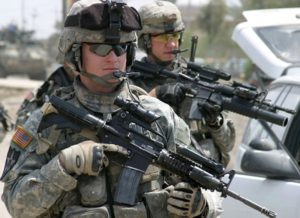The Militarization of Artificial Intelligence
AI • Jan 18,2017

The Militarization of Artificial Intelligence

US Army considers artificial intelligence and machine learning for unmanned ground vehicles, while Pentagon is working to incorporate more AI technology into military robots. Armies around the world have revealed their plans for artificial intelligence on the rear and on the battlefield. AI applications have the potential to change the character of warfare. The first nation that adapts accordingly and integrates artificial intelligence across the force will have a generational advantage on the battlefield. How can armies integrate artificial intelligence?
U.S. Army researchers are turning their attention to developing technologies that can enable ground robots to learn from their surroundings and their mistakes to enhance the ability of unmanned ground vehicles (UGVs) to operate independently without human intervention. U.S. Army explosive ordnance disposal experts in recent years have made wide use of UGVs to find and disarm improvised explosive devices and other kinds of roadside bombs intended to surprise and cripple military patrols and convoys.
UGVs of various sizes also are being developed for surveillance and reconnaissance, carrying warfighter equipment on the battlefield, vehicle inspection, checkpoints in dangerous areas, and even to fire light weapons.
Some UGVs take their instructions from human operators, others are fitted with sensors that enable them to follow their operators even over rough terrain, and some have the ability to sense and avoid obstacles. The goals of artificial intelligence research include enabling UGVs to reason, amass knowledge, plan, learn, understand spoken language, perceive obstacles and threats, and manipulate objects with robotic arms or other appendages. Machine learning and adaptation is a branch of artificial intelligence that seeks to enable UGVs and other machines to learn from data and change their behavior, methodologies, and goals based on mistakes made in the past.
While the military is experimenting with artificial intelligence applications, it is still nowhere close to designing robots with near-human levels of cognition. The military’s real goal over the next several years is to create more opportunities to integrate artificial intelligence into human-robot teaming operations. For example, Dr. Jonathan A. Bornstein, chief of the autonomous systems division for the Army Research Lab, told Task & Purpose that “we are very much focused on how unmanned systems will work together with the soldier to conduct common missions.”
In addition to these examples, Pentagon hopes that AI will power everything from cyber soldiers to the targeting systems of the F-35 – but admits it has to catch up to commercial AI firms. The important project is F-35’s special smart helmet, which can help pilot’s track targets, was a key project. AI was also set to control military vehicles. It envisions using augmented reality to help ground troops identify targets, sources of gunfire and help with communication. To make this a reality, the Defense Advanced Research Projects Agency (Darpa) says it has now awarded research contracts to several companies to develop the technology. This is all part of Darpa’s new Squad X Core Technologies (SXCT) program, which will give US troops the ability to see a ‘multi-faceted picture of their operational environments.’ This would include the location, nature and activity of both threats and allied forces around them. Technology is already made this type of real-time environment awareness available for aircraft, submarines and tanks. Infantry squads, however, have fallen behind because many of these systems are too bulky to carry on the frontline.
We already prepared an article about artificial intelligence-powered robots that will change the military industry in near future but it’s worth to remind that military already uses a host of robotic systems in the battlefield, from reconnaissance and attack drones to bomb disposal robots. However, these are all remotely-piloted systems, meaning a human has a high level of control over the machine’s actions at all times.
Darpa’s SXCT program aims to develop technologies that could be integrated into user-friendly systems. It has awarded initial contracts for SXCT to companies including Lockheed Martin, Raytheon, Helios Remote Sensing Systems and SoarTech. It has remained tight-lipped about exactly what technologies these organisations are developing. But it has outlined a number of technical areas that it wants to tackle. The program is looking at four key military tech advances –precision engagement, non-kinetic engagement, squad sensing, and squad autonomy.
Precision engagement involves precisely engage threats out to 0.6 mile (1,000 meters), without imposing too much additional weight. The second aim of the program is to provide technology to disrupt enemy operations. This is known as ‘non-kinetic engagement.’ The squad sensing advances will allow soldiers to detect potential threats out to 0.6 mile away. Alongside this, it wants to increase squad members’ real-time knowledge of their own and teammates’ locations to less than 20 feet (6 meters) in areas that don’t have GPS.
As we can see the importance of artificial intelligence and machine learning in modern military systems is constantly growing. There’s no doubt of its potential applications in military decision – making and international security in general. The spectrum of available and developing technologies is more than unmanned drone aircrafts or bomb disposal robots. Through a series of experiments, armies can identify ways to adapt commercially proven narrow artificial intelligence applications and develop new, which means that autonomous hi-tech combat missions are just a matter of time.
Author: AI.Business
If you like our articles, please subscribe to our monthly newsletter:
[mc4wp_form id=”763″]